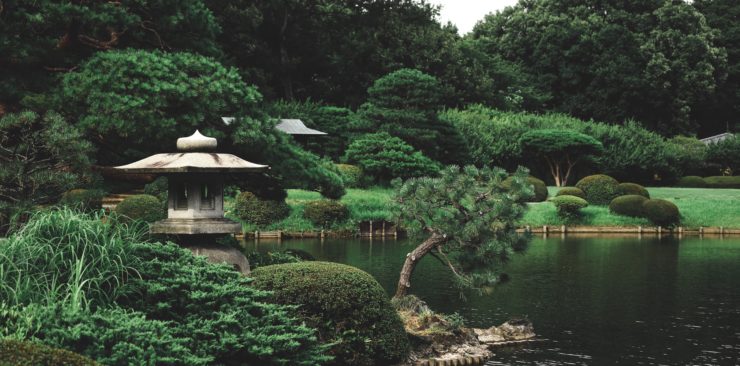John Baker, keeper of the National Hosta Collection, spoke to The Littleton and Harestock Gardening Club about gardens in Japan. He and June have travelled extensively, as we were shown in numerous slides of these remarkable gardens, many with a religious and Nature theme, and historical connection, all with distinct styles.
The three main styles are Hill and Pond, Stroll and Zen. The first two can have impressive views to appreciate; the Zen garden is a place for contemplation, “not for show.” Cherry trees, acers, azaleas, peonies and hostas, waterfalls and ponds and lakes, moss, gravel and stones were some of the recurring features. The inclusion of many traditional elements reflects the Japanese respect for the old, (that is for people and for things), that John notes persists in their culture.
Tokyo’s Imperial Palace has many extensive gardens. The Asakura Temple has a statue of the Buddha and contains his ashes. The Hama Rikya is a stroll garden with cherry trees laden with blossom. Ueno Park had a Peony Festival and the Toshogu Shrine had peonies in little straw houses . Nikko, a name which means “Pure Water” has a Botanical Garden with hostas and acers and a Shogun Shrine. The Shrines, a National World Heritage Site, are protected by ornate statues of red, angry gods; a simpler group represents Three Wise Monkeys of fable. At the foot of Mount Fuji is a Hosta Nursery, the plants grown in volcanic ash. Kyoto, the capital city, has many old houses, and thousands of shrines and gardens. Kiyomizu Temple has no flowers, only shrubs and trees. Ginkaku-ji is a spectacular gravel garden, the ground carpeted with moss, dear to the Japanese. The Zen Garden was designed by the monks, planned so as to be seen from a window, each enjoying a view, Huge stones in different sizes are in groups, representing a feature of a landscape. The Ryoan-ji Garden is plain and uncluttered, its emptiness intended to promote contemplation.
Hiroshima City has been rebuilt: where the bomb landed, in what was the commercial centre, is now. Hiroshima Peace Park. Some ruins have been retained as a Cenotaph, a memorial containing a flame that will not be extinguished until there are no nuclear weapons. About 100,000 visitors come here each year. Nara Temple Garden has deer wandering around; they are protected and fed biscuits by the visitors. This is a Buddhist centre, a building supported on large, tall columns made of wood, and with a 200 ton Buddha. The Mangor Botanical Garden cultivates plants used in commercial products. Miyajima Island has a monastery on stilts and a remarkable archway standing independently in the surrounding water, and outlined against the sky.
In his account of his travels, John clearly illustrated how Japanese gardens, originally inspired by those in China, evolved to create their own distinctive style, in turn emulated in many parts of the world.




